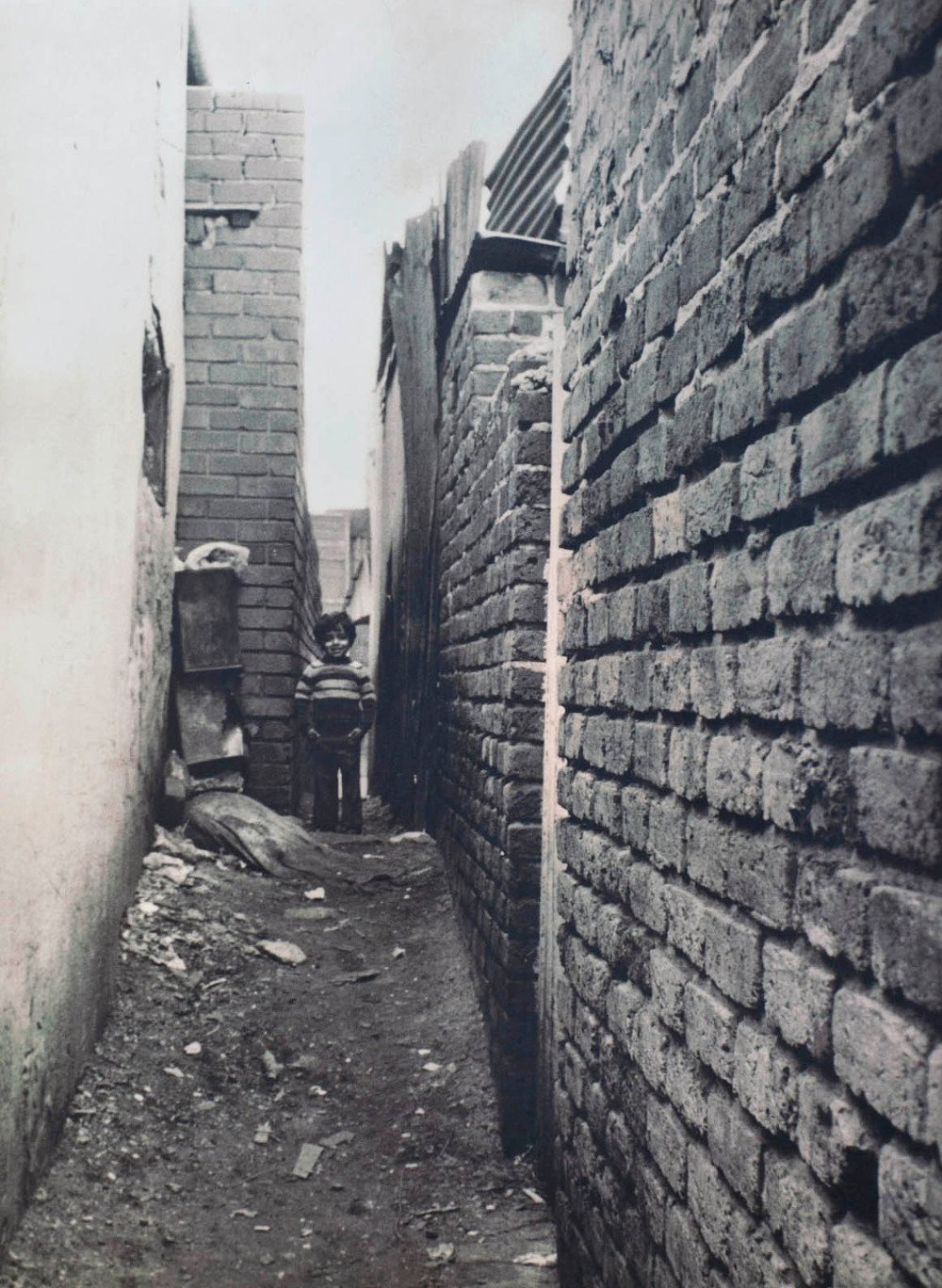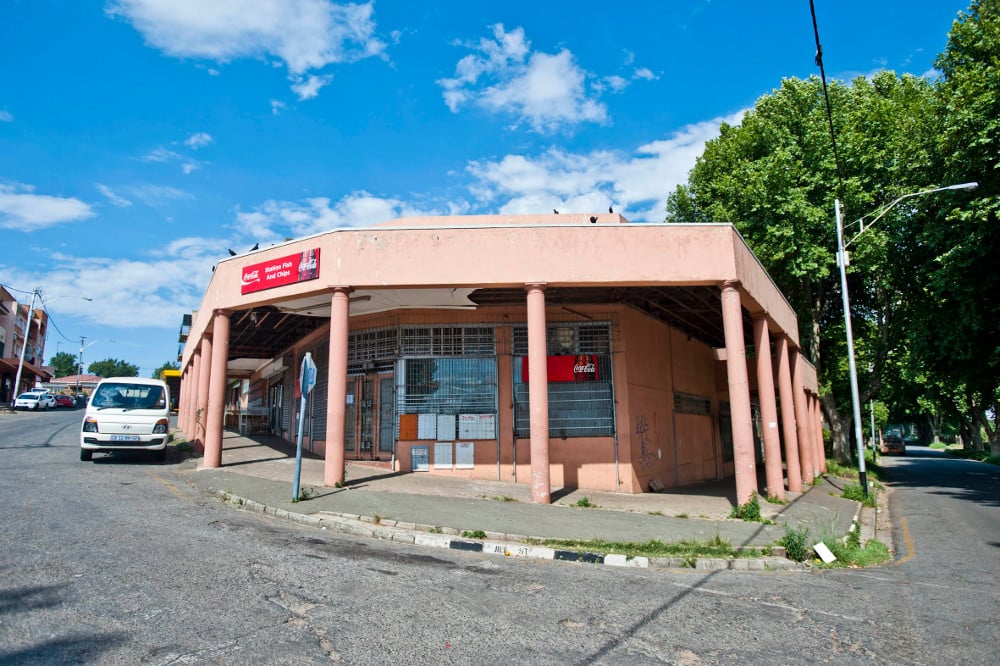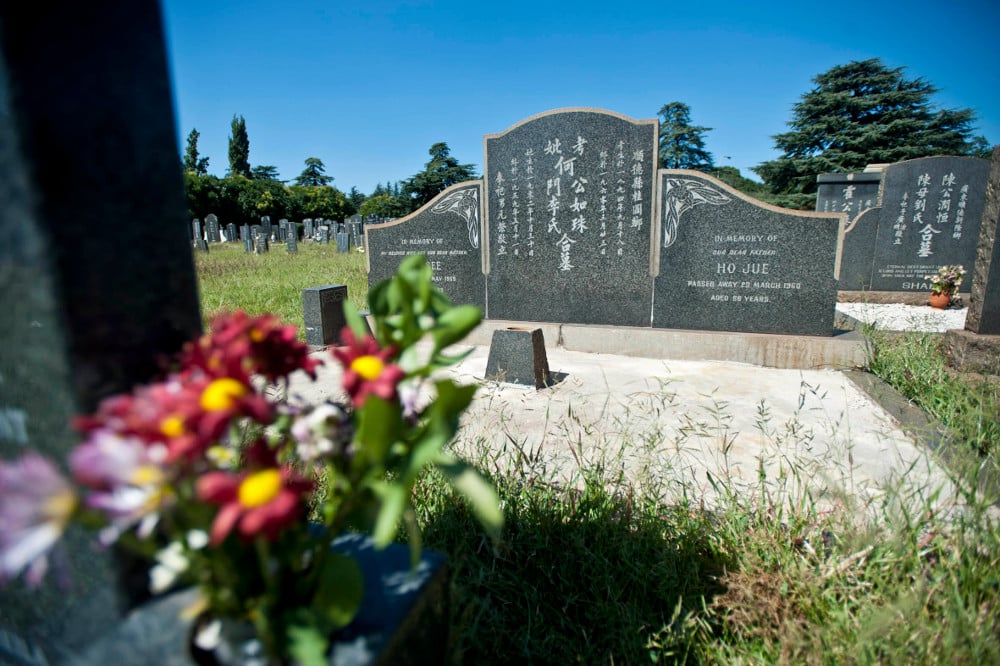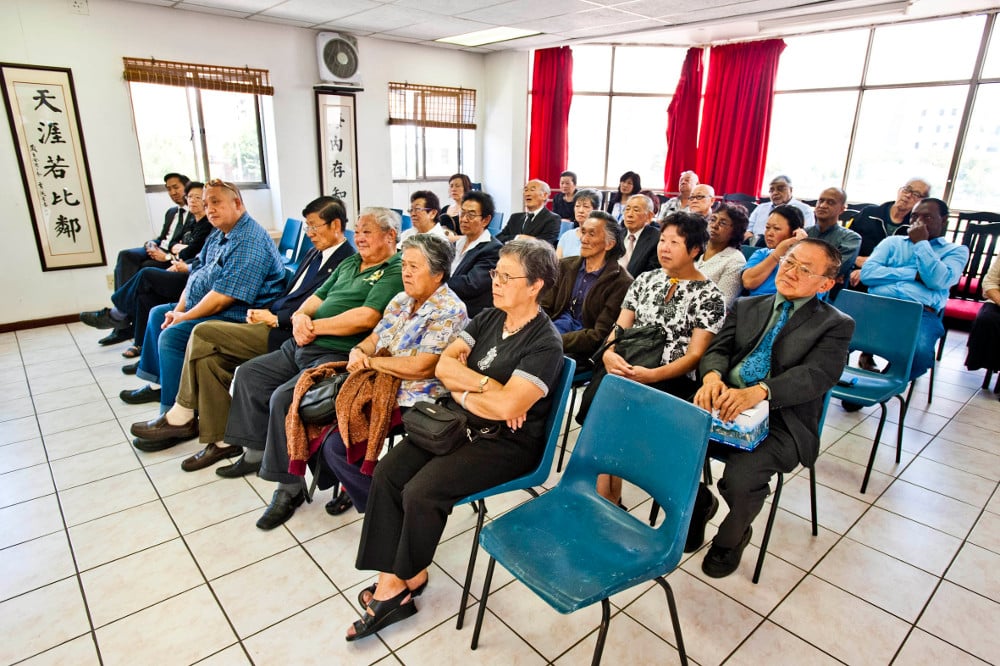The October morning police found the body of a murdered Chinese man in Langlaagte, there was no family member to call. There was no one to claim the body. No one to put a name to his face.
Neighbours, who had heard a commotion, alerted police. But they arrived too late: the 77-year-old was found dead. He had been bound and gagged.
In those early hours neighbours were only able to give police a first name: Alan. They told police he ran the Station Fish and Chips at the corner of Jill Street and Prosperine Avenue for many years and lived in the house at the back of the store, which flanks the Langlaagte train station. He sold staples of bread, airtime, canned goods, dry goods, sweets and cigarettes.
A neglected working class suburb on the western edge of Johannesburg, there’s little in Langlaagte to describe as pretty or quaint. Locals wrap what they stand to lose to crime in razor wire, burglar bars and makeshift barriers of every kind.
The old shopkeeper barricaded his storefront too, with metal armour of gates and grills. He painted over the windows to discourage prying eyes. Only the clackety-clack of trains tracing the rusty tracks was meant to penetrate his home.
But somehow attackers got through. Police said assailants jumped over the razor wire-topped garage gates and forced their way into the house. They wouldn’t have found much apart from the odd appliance, but police said the man was tortured because the criminals thought he might be hiding cash.
The death of this “yellow man”, an anonymous recluse, became just another Johannesburg murder that police might never solve.
But police still had to positively identify the body and didn’t have much to go on. They contacted the Chinese embassy as well as a local newspaper. The newspaper ran an article with scant detail, stating the victim’s name as Alan, and that he was Chinese.
What the police or the newspaper didn’t know was that the victim was not Chinese. He was South African and his name was Alan Ho. The crime scene of Alan’s brutal death didn’t hold enough clues of a long life, one lived simply but framed by the extraordinary peculiarities of South Africa’s history of segregated communities, forced removals and stories increasingly pushed to history’s periphery.
Next of kin
Somehow that short newspaper article held just enough clues for members of a Facebook group to take notice. The clipping was scanned and posted on the page of the “Fietas-Vrededorp and Pageview” group with its 340 members.
One member of the group, Kader Ferial Karbelkar, posted after reading the article: “Sad news,” Karbelkar wrote. “Alan the Chinaman from 20th Street was murdered … Cops trying to locate next of kin.”
Like other members of the group, Karbelkar was from Fietas, the unofficial name locals gave to the suburbs of Pageview and Vrededorp, west of the city. A museum that opened in September 2013 in the rundown suburb of Pageview is a solitary local tribute to the community that once thrived there. The already vandalised granite heritage plaque erected by the City of Johannesburg reads in part: “Fietas was home to African, Indian, Coloured, Malay and Chinese people of all faiths. Workers, professionals, shopkeepers, sangomas and artisans lived cheek by jowl in streets lined with mosques and churches, bioscopes, shebeens and corner cafés.”
The Fietas Museum is in a heritage building, the only building to have survived apartheid’s bulldozers in the suburb. It stands to tell the story of what unravelled there. It was in 1968 that Pageview was declared a white suburb. Traders and families were given quit notices and forced removals began. By the mid-1970s, bulldozers ended Fietas’s existence as it once was; in 1975 the last traders were finally forced out and the mixed community that once existed there all but vanished.
Fietas is conjured up now in memory, in the old photographs, recounted stories and personal effects displayed on walls and in glass cabinets in the museum, which is the private initiative of Salma Patel. The 14th Street house partly converted into the museum was Patel’s childhood home. Fietas survives here and in the virtual community of the Facebook group.
It was online, in the fortnight after Alan’s murder, that various Facebook group members were able to piece together parts of Alan’s life. They placed him back in the 1950s and 1960s in Fietas, a time when mixed communities on the wrong side of apartheid white lived together in the so-called grey areas of the city.

The Ho family’s small shop was wedged in a passage that led to the local movie house in old Fietas. (A Tayoob)
Alan’s family lived on 20th Street and he helped run the family shop there. Group members recalled that after his parents died, Ho and his sister Ming, who also used the name June, continued to run the small shop.
Facebook group member Mudney Halim remembered that the shop was wedged in a passage that led to the local Star bioscope. He remembered they sold the usual grocery provisions, but he recalled the salty, sour dried plums, just called “China fruit” – wah mui, the Cantonese call it. He also remembered fahfee, the illegal gambling game of dreams and superstitions being widely operated to help balance many Chinese families’ books. Halim remembered how the Hos were part of the “Fietas where nobody was nobody and everybody was somebody”.
Old Fietas locals recall a close-knit community. Daily life spilled on to the streets. Noisy trading gave way to wedding parties cheered on by neighbours shouting good wishes from balconies. There was blurred social stratification – little room or patience for ostentation or flash.
Feizel Mamdoo, a filmmaker, writer and community activist, recalls that he was nine years old when his family was moved from Fietas to Lenasia. It was 1968. He said the Indian people were moved to Lenasia, coloureds to areas such as Bosmont and Riverlea and blacks mostly to parts of Orlando. But the Chinese made up too small a group to be placed in a single settlement area even after the Group Areas Act was enforced in 1950. Individual Chinese families slipped into communities where they didn’t offend.
Classified “coloured” under apartheid, Chinese mostly moved into coloured neighbourhoods or grey suburbs – mixed suburbs on the lower end of the economic scale, where neighbours and authorities didn’t bother to pay too much attention.
Chinese South Africans were also given concessions over other nonwhite groups. It meant that by the mid-1970s they could live in whites-only neighbourhoods if they could afford it and if the neighbours allowed it. Apartheid’s warped reasoning placed the Chinese on a higher rung above other nonwhite groups.
Still, a family that wanted to move into a nice white suburb had to ask the permission of their neighbours – 10 houses to the front, 10 to the back and 10 on each side of the house they intended to call home.

Alan Ho ran the Langlaagte corner shop with his sister Ming until her death as a result of injuries from a violent break-in. (Delwyn Verasamy, M&G)
Alan and Ming settled in Langlaagte after a year in West Turffontein. They had always been shopkeepers and by the late 1980s they bought the Station Fish and Chips.
Mamdoo remembered Alan and his sister well enough from the Fietas days.
“I remember Alan behind the shop counter, and that he helped local children with their homework. Ming often sat outside the shop knitting and would show the young girls how to knit,” he said, weeks after Ho’s death.
Memories bring tears to Mamdoo’s eyes. Tears also fall for the trauma of deaths by violence and brutality, as well as for Fietas, an entire complex community eradicated by apartheid decree.
“Alan did not deserve to die the way he did. I want to shout at the robbers that Alan was one of our own, a highly worthy and fondly held human being, whom they dared not to know anything about but killed with a venom that is spat at aliens,” Mamdoo said.
He added: “I remember the last time Alan gave me a handful of sweets; it wasn’t like he did it all the time and I realise now that maybe I have strong memories of that because he was giving me sweets for the last time. He knew my family was leaving Fietas forever.”
Finding friends
While the Facebook group was filling in the blanks of Alan’s life through social media, one of his Langlaagte neighbours, Daisy – it’s not her real name; she’s afraid the thugs who killed Ho will return – had set out on her own quest to set the record straight.
“Alan was a loner, he was very polite and he didn’t mind people’s business. We would chat to each other every few days and I’ve had my shop here for 18 years, Alan for about 27 years. I knew he was a South African and there had to be someone in the Chinese South African community who knew him,” she said, retelling the story a month after the murder.
Because Daisy doesn’t live in the area, she wasn’t aware initially that police didn’t even have Alan’s surname, even after searching the crime scene on the morning of the murder.
She knew Alan, like Ming, never married or had any children. Marrying outside the Chinese community would have been taboo and not mixing much with the small Johannesburg Chinese community in the first place would have meant the siblings slipped off the radar of marriage suitability easily.

Alan Ho is buried with his family in Newclare cemetery. (Delwyn Verasamy, M&G)
Daisy understood this. She knew the tragedy of two years earlier when another violent break-in at their store, which stands alongside other long-established shops owned by Bangladeshi newcomers and the odd street hawker, left Ming brutalised and severely injured. She died of her injuries months later; Alan buried his sister on top of his parents’ graves in the formerly nonwhite Newclare cemetery.
On the afternoon after the murder, Daisy headed to Commissioner Street’s Chinatown. Her quest was for Alan’s story not to be slotted in with random police assumption that, with his yellow skin, he had to be one of the Chinese newcomers in South Africa. The original Chinatown came to life in the 1890s with Chinese people arriving in Johannesburg’s gold-rush days. In Chinatown she was put in contact with community elder Walter Pon. It turned out Walter knew Alan personally from school days in the old inner-city Chinese school, 60-odd years earlier.
Walter made a few more phone calls and more dots were connected. He found Alan’s old friends, men like Donald Ho-Tun and Kenneth Chun. They had maintained contact with Alan through the years, but he had always declined invitations and shied away from community activities – it was just the way he was.
Walter discovered that when Alan buried his sister there was no one at the graveside apart from Alan. It’s not Chinese custom, where community-wide final respects are the norm. There are rituals of collective mourning, but Alan took it all on his own shoulders.
“A few days later some of us from the community went to the cemetery to find his parents’ graves and the cemetery caretaker remembered the unusual sight from two years earlier: this old Chinese man burying someone all by himself. We couldn’t let Allan go without a proper goodbye,” said Walter.
Finally, Alan’s Chinese South African family had found him, and they would claim him as their own, too.
Family gathers
Mamdoo eventually made contact with the Chinese association, of which Walter is a member. The two groups, with Daisy, were now gathering from their scattered memories a fuller picture of Alan’s life – he was no longer the unknown yellow man.
As Halim posted on the Facebook page in the middle of November: “The police apparently cannot trace his next of kin; we are all his next of kin. We are related by our memory of the places we come from. Rest in peace Alan and Ming, you remain part of the collective memory of better times, and part of our hope for future communities.”
By the end of November their joint effort meant a memorial service could be held.
That hot Sunday afternoon inside the association’s building in First Chinatown, Alan’s family came together: those from Fietas, those from Langlaagte and those from the Chinese South African community.

The Chinese community gathered in First Chinatown to remember Alan Ho and recall his story. (Delwyn Verasamy, M&G)
About 30 people gathered in the room to pay their final respects. They heard about a recluse who was also a gentleman, a man who was a top pupil every year of high school. They heard, too, that he had finally decided this year he would leave his shop and move to an old age home.
Donations for his burial and service came from as far as Canada and Switzerland, it was announced.
When the story of Alan’s murder circulated in the association’s networks, people who didn’t even know Alan reached into their pockets. Daisy managed, through her charity work, to arrange for a funeral parlour to perform a cremation at a reduced fee.
It was an afternoon to remember a life and an afternoon to remember a time when history and heritage were shared, not separated along colour lines or a government’s rules of segregation.
On a table, a framed photo of Alan took centre stage. In the photo he is smiling – this quiet yellow man’s snuffed-out voice became, in death, one of the loudest.
Lost in myopia of racial assumption
When police assumed Alan Ho to be Chinese and contacted the Chinese embassy to help identify his body, it showed up the myopia of assumption.
It also showed how the story of Chinese South Africans is blurring into the sweeping narrative of newer Chinese migrants to South Africa who made Johannesburg their home from the 1990s.
First Chinatown, along Commissioner Street, came into being in the 1890s. The area was sectioned off as the Malay quarter in the city’s early days. Even today Chinatown to Cantonese speaking locals is mah lai gum. The early migrants were mostly Cantonese speakers seeking out Johannesburg for its promise of gold and prosperity. The Cantonese Club was set up in 1898; in the last two years a blue heritage plaque was placed on its façade, acknowledging the story of Johannesburg’s early Chinese community.
But while Chinatown has the pedigree of history, Cyrildene Chinatown, which mushroomed in the post 1990s democratic transition period, is the rising dragon.
There are some distinctions: the newcomers are Chinese, they mostly speak Mandarin and their story is framed by the current cosy ties between China, the ANC-led government and the muscle of China’s growing global status. An estimated 350 000 Chinese people live in South Africa today. The Chinese South Africans number only about 8 000 to 10 000. Their numbers were curtailed until the end of apartheid by immigration quotas.
First Chinatown, like Fietas, tells a distinct South African story. It marks off time, history and memory – for those who care to take notice.
- A previous version of this article spelt Alan Ho’s name as Allan. The correction has been made.